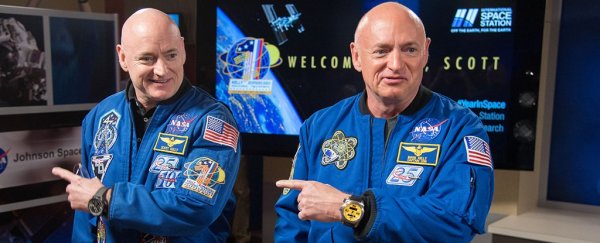For a year, between March 2015 and March 2016, NASA astronaut Scott Kelly spent his life in the microgravity environment aboard the International Space Station, hundreds of kilometres above Earth. His identical twin and fellow astronaut, Mark, stayed down here.
This was a unique opportunity. The Kelly brothers are genetically identical, which meant scientists had an Earth-based control to track the changes to Scott's body due to living in space. Now they have delivered the first comprehensive, integrated multiomic analysis of the effect of long-term spaceflight on the human body.
"This team of teams has conducted a study unprecedented in its scope across levels of human biology: from molecular analyses of human cells and the microbiome to human physiology to cognition," said Craig Kundrot of NASA's Space Life and Physical Sciences Research and Application Division.
"The Twins Study has been a pioneer and a driver for NASA to develop research policies suitable for cutting edge omics analyses. This paper is the first report of this highly integrated study that began five years ago when the investigators first gathered."
Humans have lived on Earth for millennia. We were born on Earth, we evolved on Earth. But put us in space, in microgravity and ionising radiation, and things start to change.
We can track some of those changes in individuals - it's how we know, for instance, that long spaceflight can result in anatomical changes to the eye, rapid loss of bone density, and microstructural changes in the brain.
But with twins, we can really drill down into the nitty gritty, observing changes on the molecular level. And that's what 10 teams of scientists around the world did for NASA's Twin Study.
In the new paper, they describe a variety of changes in Scott's body compared to Mark's. We already knew from preliminary results that the oxygen deprivation stress, increased inflammation, and dramatic nutrient shifts from living in space had caused a 7 percent shift in Scott's gene expression, especially related to the immune system.
Changes in Scott's eyes - including flattening of the eyeball and a thicker retinal nerve - were consistent with what had been observed in other astronauts, as was his bone density loss.
One team found that spaceflight causes a shift in the ratio of bacteria in the gut microbiome - although the diversity of microbiome bacteria doesn't change. This knowledge could help design a regime of pre-, pro- and postbiotics for the mission to Mars to help keep the microbiome healthy.
The flu vaccine works just as well in space as it does on Earth, so that's good news. There were other positive changes, too. It seems Scott's diet and exercise regime was a little healthier, even in space, than Mark's on Earth, resulting in reduced body mass.
Interestingly, the telomeres in Scott's white blood cells changed length. These are the protective caps at the ends of our chromosomes, and typically, they grow shorter over time, with each cell division, until they're so short they can't divide any more. Although some of Scott's telomeres shortened, some grew dramatically longer, contrary to all expectations.
Ionising radiation caused some structural changes in Scott's chromosomes, and the microgravity environment saw thickening of his carotid artery walls and loss of collagen. There were some cognitive changes too. Although Scott's cognitive abilities remained fine in space, they did decline after he had returned to Earth.
Most of these changes, thankfully, were temporary - but a return trip to Mars, which would be much longer, would likely see these effects increase, perhaps exponentially. And, although he is basically back to normal now, some of the changes persisted.
"Although average telomere length, global gene expression, and microbiome changes returned to near preflight levels within six months after return to Earth, increased numbers of short telomeres were observed and expression of some genes was still disrupted," the researchers wrote in their paper.
"These multiomic, molecular, physiological, and behavioural datasets provide a valuable roadmap of the putative health risks for future human spaceflight."
The research has been published in Science.
